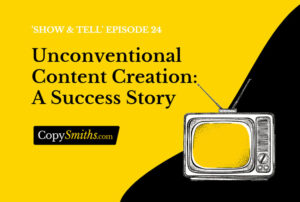Home » Content Marketing » Effective Content Ideation Tips for Dull/Difficult/Boring Industries

Effective Content Ideation Tips for Dull/Difficult/Boring Industries
Boring industries can be a drain both on the content strategist’s and the reader’s natural life forces.
Ever found yourself content planning for hygiene services, tire retailers, or tax agencies? If yes, then you know exactly what we mean.
But does this make you cursed for life with nothing else to do but bore your readers stiff until there’s no one left to read your content?
Not necessarily so.
Only a few tricks can make your content ideation struggle less soul-wrenching.
Those who know how to churn out content ideas for difficult niches know these 2 things very well. You need to:
- Detach yourself from mere product promotion.
- Give more room to lateral thinking.
So, how do you nail it with your content marketing strategy when life deals you bad cards, so to speak? Learn how with our effective content ideation tips for boring industries.
Look for a Fun Angle While Content Ideating
There will be times when any hope you’ve had of spawning a decent content idea will dwindle and die.
Particularly with industries dominated by dry facts and legislative lingo. Think tax, mortgages, life insurance (Groundhog Day movie, anyone?)
But the truth is there are shortcuts you can take. And those shortcuts can take you to an agglomeration of note-worthy ideas even in such fields.
Mind you, it’s neither witchcraft nor wizardry.
“Anything can be exciting if you can tell a story and entertain your audience. You don’t want to explain, you want to show. Your enthusiasm will rub off on the reader, so you want to write about something that you know that you are interested in. If you can have fun with the topic, so can the reader.” – Source: Reddit
So, how do you do that? By:
Getting outside of traditional thinking
Finding a point of interest that appeals both to you and your readers
Adding a fun twist to the topic
Instead of putting your audience to sleep with “What Are the Best Materials to Choose for Your Toilet Fixtures”, go with an article that lists interesting toilet trivia.
For example, when was it first in the history of filmmaking that a movie featured a toilet? What are some epic movie scenes set in a toilet setting, etc?
Write about fun ideas for the office washroom, or make a list of fun washroom etiquette posters.
Want some more fodder to help you lighten up your digital content strategy? Here are some content marketing strategy examples that work in the real world.
Example 1
Hims, the USA men’s wellness brand does a great job of tackling delicate health topics. Among others, they cover the hair loss and erectile dysfunction topics in a bold and witty way.
They use a light tone to talk about some of the most serious (and boring) topics.
Here are some of their stellar content examples:
- Hair Loss Cure for Men in 2020? No, But There Are Options
- Causes of Impotence: Here’s What to Consider
- No Jet Lag, No More: Here’s How to Beat It
Example 2
A case study by Brian Dean shows you can get attention even with topics people consider boring.
He proves his point citing an example of a piece of content in the organic pest control niche. Quite boring stuff.
The marketers in the case study managed to rake in 60 referring domains with a single content piece. Crazy, right?
So, how did they do that?
They thought of an interesting idea. They created a fun infographic giving the nuts and bolts of how bugs can help you defeat garden pests.
So, there you go: a perfect example of finding a fun angle to a boring topic!
Explore Tangential Topics
Yes, you can create a few product-based articles every so often. But anchoring your content strategy to your products and services alone is a bad idea.
You know better than that!
Go lateral, take a more general grasp of your topic. This increases the likelihood of creating content that will resonate with your audience.
Keeping your mind open to new ideas is how you tap into that elusive potential of your boring industry.
Here are some actionable content ideation tips:
- Keep learning about your industry. Learn what forums, news sources, YouTube videos your audience frequents. Keep them on your radar. Extract new ideas for your content from those sources.
- Brainstorm. Find tangential topics that relate to your products or services. Research for questions related to whatever it is that you’re selling. Explore even the faintly related concepts.
- Choose an angle your audience can relate to. What interests your audience, what makes them tick?
Let’s say you run a company that sells mileage tracker apps for calculating car expenses for tax return. What do you do after you bore people with “The Standard Mileage Deduction Rules” types of articles?
You brighten things up a bit with:
- How to Choose the Best Mileage Tracker App For Uber And Lyft
- How to Maximise Your Work-related Tax Deductions
- How to Pick the Best Mileage Tracker App That Doesn’t Drain Your Battery
See? This makes much more sense to the reader. The topics are tangential but still very relevant both to the readers and to the product.
But what else can you do to spark interest? We’ve found our answer over at Search Engine Journal. They’ve found a neat solution on how to engage the reader in a generally boring automotive industry.
It’s simple: make the readers participate.
They come up with a survey to create interesting, unique, and link-worthy content.
The survey is about a quite specific topic that’s stirred up a hot debate in the automotive industry. And the participants are called to give their two cents on the use of touch screens vs. dials.

Source: searchenginejournal.com
Create Solution-Oriented Content
There’s nothing that can take your content marketing strategy off the ground as successfully as solution-oriented content.
People who do business with boring industries also have some pressing issues! Burning topics they need to solve, sometimes on short notice.
And they’ll be very keen to find a solution.
So, how do you take a relatable approach to your content creation? By answering a simple question and then offering solutions to people. The question is:
Why Have the Users Landed on Your Page?
Go and tap into the reasons why people browse for your topics. Think of real people doing real-life business. Put yourself into their real-life situations.
Now, let’s go back to our mileage tracker app example, remember that? So, why would anyone search for an app like that?
- Are they Uber or Lyft drivers seeking how to record their car expenses? Mileage tracker apps help rideshare drivers record mileage and write off car expenses.
- Are they running a small business? A small business can reap massive benefits by using a mileage app. They can minimize taxes, cut down on the mileage logging time, and manage fuel consumption.
- Are they Shipt users? Mileage tracker apps can help with grocery lists when shopping from this marketplace.
This line of thinking can help you come up with a bunch of content ideas and be confident they’ll spur some interest.
Tell your readers how your product can help them save money, streamline their business, and simplify their chores. People will be hooked on, no matter how dullish the topic seems at the start.
Like Our Content Ideation Tips? Take Them for a Spin
To sum up, finding topics for boring industries doesn’t have to be that traumatic. The content ideation tips above will help you make an effective strategy while taking the vexation element out of the equation.
This is possible.
But you need to know where to look. How to deconstruct the puzzle and leave the boring elements out.
It’s like with any other aspect of your business. You have to know where to look for peer advice and valuable partnerships.
CopySmiths
I'm Katrina McKinnon, founder of CopySmiths and Small Revolution. In my 20 years of experience, I have helped online businesses create high-performing content specifically on an eCommerce store's blog. Find me on LinkedIn and Twitter.

CopySmiths offers the best blog writing services for online stores.
If you'd like us to write blog articles for you, click here.
Most Recent
- 3 Bold Questions You Should Ask When Hiring A Content Writer

- 5 Practical Reasons You Should Use a Blog Post Template

- 4 Amazing Benefits of Using a Title Generator for New eCommerce Blogs

- 10 Awesome Bio Examples Your Online Store Blog Should Emulate

- 8 Basic Steps to Successful Content Development Every Time

Podcasts
Got a question?
Ask our friendly team about our article writing services.
Subscribe to CopyZine
Monthly, hand-picked stories of the best in eCommerce Content.




